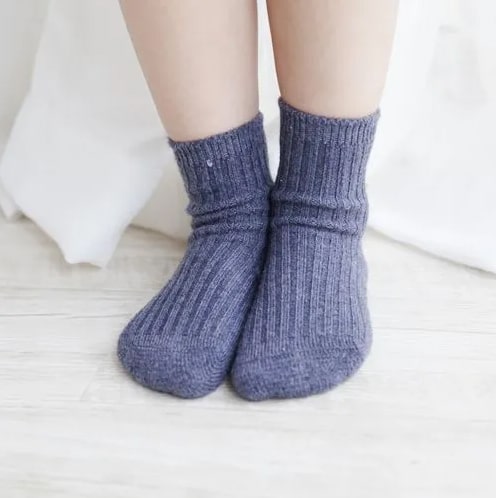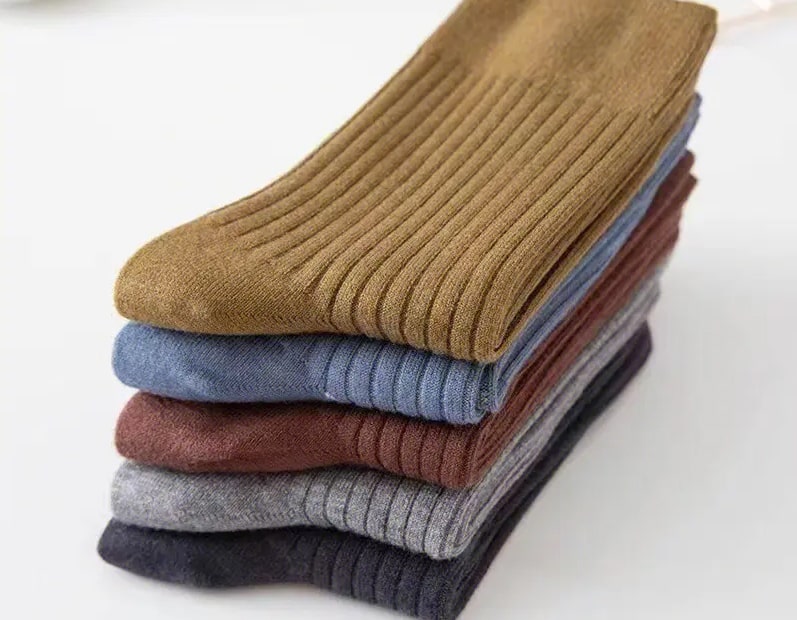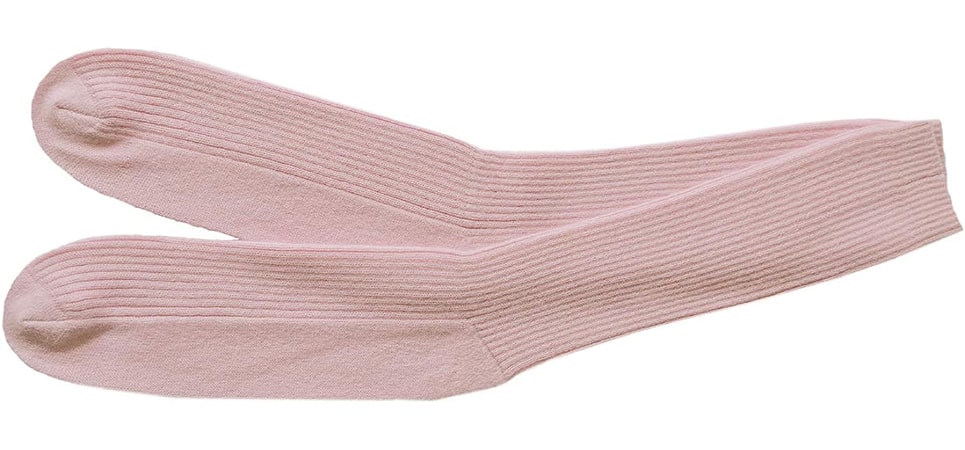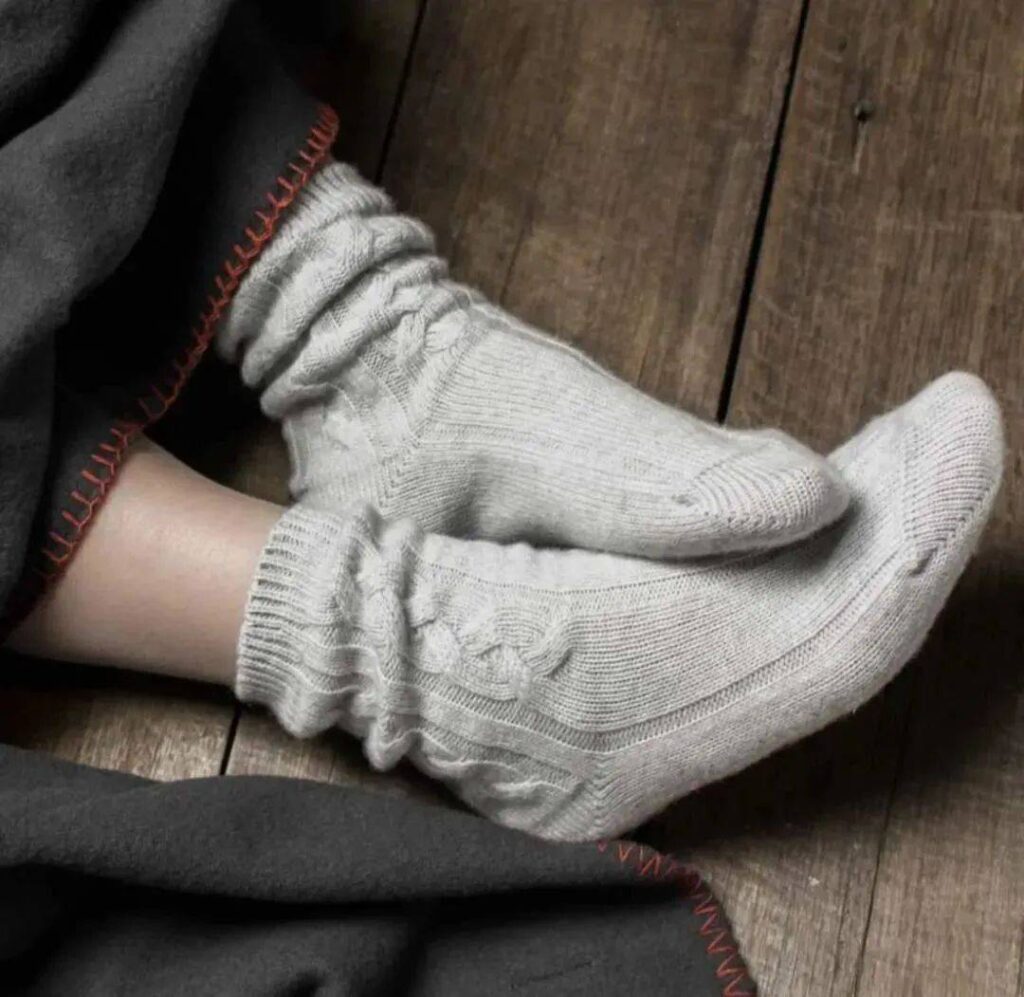Cashmere wool, from which cashmere socks are made, has a rich and storied history dating back centuries. Originating from the Himalayan regions of Mongolia, China, India, Iran, and Afghanistan, cashmere has been treasured for its unparalleled softness, warmth, and durability.
The word “cashmere” itself comes from “Kashmir,” a region located in the northern part of the Indian subcontinent, where this fine wool was originally woven into luxurious textiles. However, the process of crafting items from cashmere was laborious, limiting its use primarily to royalty and the upper echelons of society.
The goats that provide this exceptional fiber, known as cashmere goats, survive in harsh and cold climates, developing a unique double fleece as protection. The outer layer is coarse and protects the animal from the weather, while the inner layer, known as the underdown, is incredibly soft, providing the warmth. It’s this underdown that’s harvested to create cashmere wool.

As for the origin of cashmere socks specifically, it’s hard to trace back an exact timeline or location.
What we do know is that with advancements in spinning and knitting technologies during the Industrial Revolution, the production of cashmere garments became more affordable and widespread, enabling the creation of smaller items like socks.
The process of making cashmere socks involves dehairing to separate the soft underdown from the coarse outer hairs, spinning the fibers into yarn, and then knitting the yarn into socks.
Given the natural warmth, softness, and lightweight nature of cashmere, it wasn’t long before these socks gained popularity for their luxurious comfort and insulating properties, and they continue to be a cherished luxury item to this day.
What are Cashmere Socks?
Cashmere socks are hosiery items made from the unique fibers derived from the undercoat of cashmere goats. Cashmere is a type of wool but is set apart by its exceptional properties, derived from the extraordinary adaptive capabilities of cashmere goats living in harsh climates.
The fiber diameter, or denier, of cashmere is extremely fine, typically between 14 and 19 microns, compared to the average sheep’s wool fiber diameter of 35-45 microns. This translates into a fabric that is softer to the touch and has superior insulating properties.

Due to the density of the fiber, cashmere socks have exceptional thermal properties. They can offer up to three times more insulation than ordinary wool, making them a preferred choice for winter weather or for those seeking additional warmth.
At the same time, cashmere has excellent breathability due to its moisture-wicking properties, which refer to the ability of the material to draw moisture away from the skin. This creates a microclimate around the foot that keeps it warm and dry in the cold, yet cool and comfortable in heat, thereby providing all-year-round comfort.
Furthermore, despite its lightweight nature, cashmere has an impressive tensile strength that contributes to the durability of the socks. When properly cared for, cashmere socks maintain their shape, softness, and comfort for years, presenting long-term value for their higher upfront cost.
Finally, cashmere socks come in a variety of styles, lengths, and colors to cater to different tastes and needs. They can be ankle-length, crew-length, or even knee-high, and are available in an array of patterns and colors, from the classic solid hues to more vibrant, patterned designs. The versatility and range of cashmere socks make them suitable for both formal and casual settings.
How to Choose Quality Cashmere Socks

Choosing quality cashmere socks involves a careful examination of several key attributes.
Here’s a breakdown of the factors you should consider in a data-driven manner:
- Cashmere Fiber Quality
The quality of cashmere fibers is primarily determined by their length, diameter, and color.
High-quality cashmere typically has a fiber length of 34-36mm and a diameter of less than 19 microns.
These long, thin fibers create a softer, warmer, and more durable fabric.
- Ply of Cashmere
Cashmere Ply refers to the number of threads twisted together to form the cashmere yarn.
Socks made from multi-ply yarn (2-ply or more) are usually more durable and less prone to holes than those made from single-ply yarn.
They are also likely to pill less over time. However, the ply is not the sole determinant of quality, as the quality of the fibers used in the yarn also plays a significant role.
- Knitting Density
A higher knitting density generally means a higher quality sock. The density affects both the durability and the warmth of the socks. It can be assessed by lightly stretching the sock to see if it easily deforms or if the knitting structure holds well.
- Manufacturing Process
The manufacturing process can greatly influence the quality of cashmere socks. Those made using traditional methods, such as hand-combing the goats and hand-knitting the socks, are often of higher quality. It’s also worth considering whether the socks have been made sustainably and ethically.
- Company Reputation
Companies with a long-standing reputation for quality and craftsmanship are often more reliable when it comes to sourcing and producing high-quality cashmere socks.
- Price
While price should not be the primary factor in determining quality, it’s worth noting that cashmere is a premium material that requires a labor-intensive process to produce. Thus, socks sold at a surprisingly low price might not be true cashmere or of good quality.
Remember that the ultimate goal is to find a balance between comfort, durability, warmth, and price that suits your individual needs and budget.
I have compiled a list of the best women’s cashmere socks, in case you need inspiration.
Care for cashmere socks
Proper care and maintenance of cashmere socks are paramount in preserving their softness, durability, and insulating properties. Here are scientifically grounded tips to help extend the life of your cashmere socks:
- Washing
Cashmere fibers are delicate, hence it’s advised to hand wash cashmere socks in lukewarm water (around 30°C) using a mild detergent specifically designed for delicate fabrics. If using a washing machine, select a gentle cycle and use a mesh bag to protect the socks. Studies show that mild mechanical action can prolong the life of the cashmere fibers.
- Drying
After washing, avoid wringing the socks, as this can distort their shape and damage the fibers. Instead, gently press out the excess water and lay them flat on a clean towel, then roll the towel to absorb more water. Unroll and leave the socks to air dry naturally, away from direct heat and sunlight which can cause shrinkage or color fading.
- Storing
To avoid the risk of moth damage, ensure your cashmere socks are clean before storing. Moths are attracted to food particles and body oils. Store your socks in a cool, dry place, preferably folded in a drawer or in a breathable cotton storage bag. Avoid hanging or using mothballs, as the former can distort the shape and the latter can leave an undesirable smell and is toxic.
- Pilling
Over time, cashmere may naturally pill due to friction. These are small bobbles of fiber that appear on the surface. Pilling is not indicative of poor quality but a natural characteristic of the long fibers. Remove pills using a cashmere comb or a pill remover, gently de-pilling in one direction.
- Repairing
If your cashmere socks develop a hole or tear, they can often be repaired. Darning, a traditional method of repairing holes in knitwear using needle and thread, can extend the life of your socks. You can find instructional videos online or seek professional services.
Proper care not only helps retain the quality of your cashmere socks but also enhances their lifespan, making your investment in these luxury items more worthwhile. Studies suggest that extending the life of your clothes by just nine months can reduce their carbon, water, and waste footprints by 20-30%.
Why invest in cashmere socks?
Investing in cashmere socks can provide a range of benefits, justifying their higher price tag compared to other types of socks. Here are the key reasons, backed by data and professional insight:
- Superior Comfort and Insulation
Cashmere is notably softer and more comfortable against the skin than traditional wool.
Moreover, cashmere fibers have exceptional insulating properties. They are able to keep your feet up to three times warmer than regular wool, making them excellent for cold climates or individuals with cold-sensitive feet.
- Breathability and Moisture-Wicking
Despite their warmth, cashmere socks offer excellent breathability due to the structure of cashmere fibers. These socks can regulate temperature and wick away moisture, reducing the likelihood of sweaty or clammy feet and promoting a comfortable microclimate around your foot in diverse weather conditions.

- Durability and Longevity
Quality cashmere socks, when cared for properly, are highly durable and can retain their shape, softness, and comfort for years. This durability results from the natural strength of cashmere fibers and the high knitting density often employed in quality cashmere socks. This long-term durability provides a good return on investment, as the socks do not need to be replaced as frequently.
- Luxurious Experience
Wearing cashmere socks is often seen as a mark of sophistication and luxury due to the rich history and prestigious reputation of cashmere. Whether worn at home for added comfort or on special occasions, they offer an elevated sensory experience.
- Sustainable Fashion Choice
When sourced responsibly, cashmere can be a more sustainable choice compared to synthetic alternatives. Unlike petroleum-based fibers, cashmere is renewable, biodegradable, and requires significantly less energy to produce. Investing in a pair of cashmere socks can thus be a step towards a more sustainable wardrobe.
- Health and Wellness
Cashmere socks can also contribute to personal health and wellness. They offer a solution for individuals with sensitive skin as they’re less likely to cause irritation or allergies compared to synthetic materials. The warming effect of cashmere can also assist with circulation issues, providing therapeutic benefits for conditions like Raynaud’s disease.
In conclusion, while cashmere socks may require a higher initial investment, their superior quality, comfort, and durability, along with their potential health benefits and environmental advantages, make them a worthwhile addition to any wardrobe.
Conclusion
In the realm of premium hosiery, cashmere socks stand as a paragon of luxury, comfort, and durability. Their magic lies in the unique properties of cashmere fibers, presenting a delightful blend of superior insulation and breathability. Yes, they come with a higher price tag, but it’s an investment worth making.
Consider this – cashmere socks are not just about keeping your feet warm; they’re about indulging in a piece of timeless luxury, supporting sustainable fashion, and experiencing unparalleled comfort.
So whether it’s a gift for a loved one or a treat for yourself, stepping into a pair of cashmere socks is like stepping into a personal oasis of warmth and softness. The benefits are long-term, making cashmere socks not just a purchase, but an investment in your comfort and well-being.
FAQ
Can cashmere socks be worn all year round or are they only for colder months?
Despite being renowned for their superior warmth, cashmere socks are incredibly breathable and moisture-wicking, making them suitable for year-round use. They help maintain a comfortable temperature around your foot, keeping you warm in colder months and cool in warmer ones.
Are cashmere socks suitable for individuals with sensitive skin?
Yes, cashmere is typically suitable for individuals with sensitive skin. Cashmere fibers are softer and finer than traditional wool, reducing the likelihood of skin irritation. However, it’s important to check for any added synthetic materials or dyes that might cause a reaction.
Can I wear cashmere socks with any type of shoes?
While cashmere socks can technically be worn with any type of shoes, it’s advisable to avoid wearing them with shoes that are tight or might cause a lot of friction, which can wear out the socks more quickly. They’re ideal for wear with well-fitting boots, loafers, or simply around the house for added comfort.
Can cashmere socks be mended if they get a hole or tear?
Yes, small holes or tears in cashmere socks can often be mended using a method called darning, which involves sewing the hole with a needle and thread. This can extend the life of your socks and is more sustainable than replacing them.
Why do cashmere socks sometimes pill and what can be done about it?
Pilling is a natural process that occurs when loose fibers on the surface of the socks start to tangle under friction. It’s not indicative of poor quality but rather a characteristic of many natural fibers. Pills can be carefully removed using a cashmere comb or pill remover, and frequent washing can also help reduce pilling.
Do cashmere socks require special storage?
Cashmere socks should be stored in a cool, dry place away from direct sunlight. Ideally, they should be folded and placed in a drawer or breathable cotton bag. It’s important to ensure they are clean before storing to prevent moth damage.
Can cashmere socks contribute to sustainable fashion?
When sourced responsibly and cared for correctly, cashmere socks can be part of a sustainable wardrobe. They are made from renewable resources, are biodegradable, and have a longer lifespan than many synthetic alternatives. Additionally, extending the life of clothing items, such as repairing socks instead of replacing them, can significantly reduce environmental impact.
